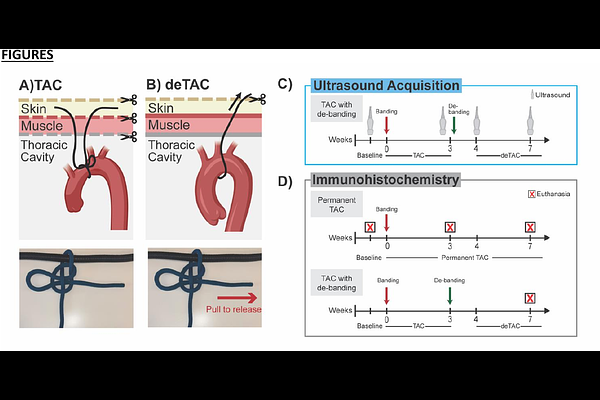Simplified and refined murine model of reversible aortic constriction for characterizing cardiac functional recovery

Simplified and refined murine model of reversible aortic constriction for characterizing cardiac functional recovery
Ghajar-Rahimia, E.; Sicard, P.; Castel, L.; Goergen, C. J.; Moore-Morris, T.
AbstractBackground: Heart failure with reduced ejection fraction (HFrEF) is a major clinical issue with a poor prognosis. Structural and functional recovery, known as reverse remodeling (RR), has been observed in subsets of patients who respond favorably to treatment. However, progress in understanding the mechanisms behind RR has been hindered by a lack of animal models that accurately replicate this complex process. Objectives: We introduced a convenient and reproducible modification to the widely used transaortic constriction (TAC) procedure allowing refined, timed, and noninvasive aortic debanding (de-TAC), and functional recovery. Methods: A modified and releasable knot was used for an initial aortic constriction. Suture ends were left accessible above the muscle layer following the initial TAC surgery. Re-opening in the skin after three weeks and gently pulling on the suture ends resulted in de-TAC. We assessed cardiac morphology, function, and strain with 2D and 4D ultrasound, respectively, at baseline, 3 weeks after TAC, 1 week after deTAC, and 4 weeks after deTAC. Tissue remodeling and cellular infiltration was characterized by quantifying fibrosis and fibroblast numbers via immunofluorescence. Results: Ultrasound revealed that aortic de-banding was associated with both functional and mechanical recovery. Cardiac function and strain decreased due to pressure overload, exhibiting characteristics of systolic dysfunction, but recovered to near baseline values by 1 week after deTAC. However, left ventricular mass, fibrosis and fibroblast numbers remained elevated, despite functional recovery. Conclusion: This simplified and refined TAC-based model of RR significantly facilitates and enhances research on cardiac remodeling and recovery.